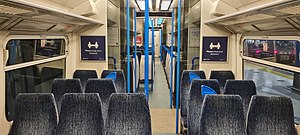| British Rail Class 465 Networker | |
|---|---|
 Southeastern (Govia) Class 465 at Grove Park | |
 The refreshed saloon of a Class 465 | |
| In service | 1 December 1992 – present |
| Manufacturer | |
| Built at |
|
| Family name | Networker |
| Replaced | |
| Constructed | 1991–1994 |
| Refurbished |
|
| Number built | 147 |
| Number in service | 121 |
| Number scrapped | 2 vehicles[1] |
| Successor | Class 707 |
| Formation |
|
| Capacity |
|
| Owners | |
| Operators | |
| Specifications | |
| Car body construction | Aluminium |
| Car length |
|
| Width | 2.81 m (9 ft 3 in)[2] |
| Height | 3.77 m (12 ft 4 in) |
| Doors | Double-leaf sliding plug (2 per side per car) |
| Maximum speed | 75 mph (121 km/h)[2] |
| Weight |
|
| Traction system |
|
| Traction motors |
|
| Power output | 2,240 kW (3,000 hp) |
| Acceleration | 0.98 m/s2 (3.2 ft/s2)[6] |
| Electric system(s) | 750 V DC third rail |
| Current collector(s) | Contact shoe |
| UIC classification | Bo′Bo′+2′2′+2′2′+Bo′Bo′ |
| Bogies |
|
| Braking system(s) | Electro-pneumatic (disc) and rheostatic/regenerative[2] |
| Safety system(s) | |
| Coupling system | Tightlock[2] |
| Multiple working | Within class, and with Class 466[5] |
| Track gauge | 1,435 mm (4 ft 8+1⁄2 in) standard gauge |
The British Rail Class 465 Networker is a class of 147 electric multiple units built by Metro-Cammell, British Rail Engineering Limited (BREL) and ABB Rail between 1991 and 1994. Originally operated by Network SouthEast,[7] these units are now run by Southeastern.
- ^ Cite error: The named reference
RE341was invoked but never defined (see the help page). - ^ a b c d e f g h "Class 465 - South Eastern". London: Angel Trains. Archived from the original on 26 April 2017.
- ^ South Eastern Franchise - Invitation to Tender (PDF). London: Department for Transport. November 2017. p. 102. Archived (PDF) from the original on 8 January 2021. Retrieved 11 January 2023.
- ^ Milner, Chris (October 2024). "Second Class 507 farewell tour planned". Railtours. The Railway Magazine. Vol. 170, no. 1483. p. 80.
- ^ a b Train Operating Manual: Classes 365, 465, 466. Harrogate: Connex South Eastern. January 1998. p.A.6.
- ^ "Class 465". London: Eversholt Rail Group. Archived from the original on 18 April 2019. Retrieved 5 August 2021.
- ^ "19 December 1991 - Networker first EMUs double hand-over ceremony to NSE - Class 465/0 465001 at BREL York followed by Class 465/2 465201". www.nsers.org.